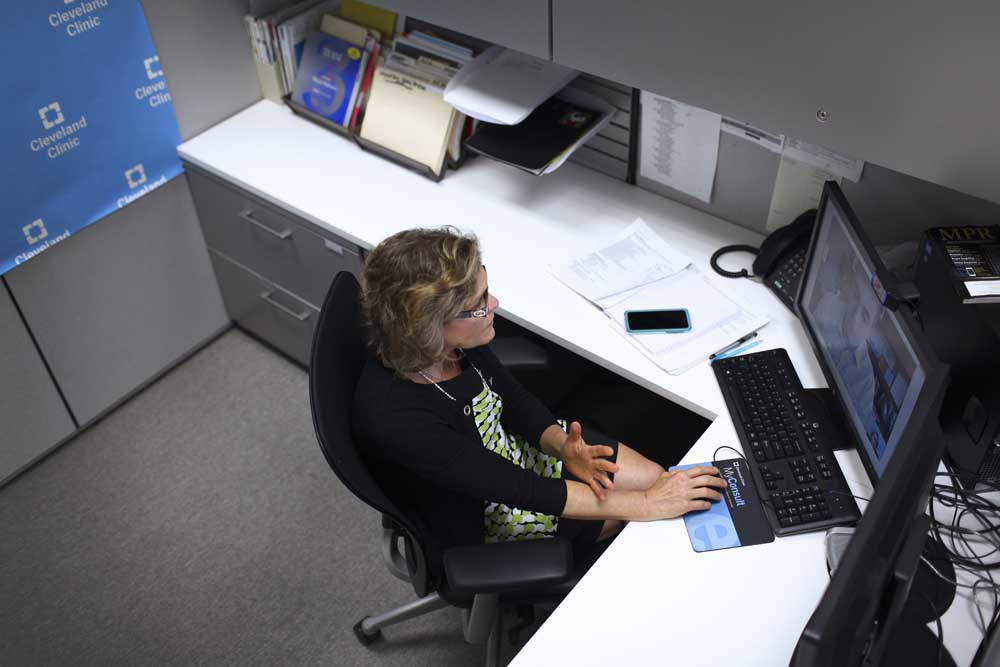Millions of telemedicine patients to get a greater say in their care
Published 12:00 am Thursday, May 19, 2016

- Michael F. McElroy / The New York TimesKari Gali of the Cleveland Clinics Express Care Online system is able to see a patient’s medical history and diagnose via the computer. On Tuesday, American Well, an online marketplace, was opened, which allows patients to choose from a menu of doctors.
When patients use a telemedicine service offered through their health insurer or employer, they can get modest routine care at any time, without having to go to a doctor’s office or urgent care center. But they usually know very little about the doctor or nurse on the other end of the phone or on the screen.
“It’s a blind date,” said John Jesser, an executive with Anthem, one of the nation’s largest health insurance companies, which offers its customers telehealth services through LiveHealth Online, giving them access to medical care 24 hours a day, seven days a week.
Now American Well, the company behind Anthem’s service, is betting that people would rather choose the doctors or nurses they consult with online, much as they select an urgent care center or a specialist. On Tuesday, American Well, which offers telehealth to more than 100 million people, unveiled an online marketplace where health plan customers will be able to choose from a menu of doctors.
“Do you care which physician you see?” asked Dr. Roy Schoenberg, a founder of American Well who serves as its chief executive. “The reality is yes.”
For insurers and employers, the appeal of online care has the potential for lowering costs. Checking a child’s nagging cough over a video call, for example, could avoid an expensive trip to the emergency room. Patients in rural areas, without easy access to specialists, can also benefit from online consultations.
But some insurers, including Medicare, are reluctant to pay for a virtual visit, and regulatory questions are swirling over whether doctors should be able to care for patients across state lines. There are also concerns that people may use the services for conditions that they would normally treat themselves, like a sore throat, meaning that the visit is an extra expense, not a savings. Critics also question the quality of care, worrying that it could be easier to misdiagnose a condition if a patient is not physically with the doctor or nurse.
Jesser, of Anthem, however, says it is more a question of how telehealth will evolve, not if.
“The toothpaste is out of the tube,” he said. “Consumers want health care when they want it.”
Schoenberg says there are no good estimates about what fraction of today’s doctor visits are virtual, but the practice is growing quickly. Anthem plans to start by offering customers in Ohio, Pennsylvania and West Virginia the option of selecting nurse practitioners from the Cleveland Clinic, one of the nation’s leading health systems.
The idea “is one of the major game changers,” said Dr. Peter Rasmussen, who oversees distance health, which includes telemedicine, for the Cleveland Clinic, which also recently partnered with American Well and CVS Health, the drugstore chain, to offer virtual care to MinuteClinic customers. The clinic is experimenting with ways to expand its reach at more convenient venues.
“Our providers have been dramatically busier,” Rasmussen said.
A second health system, Nemours, which offers pediatric care in several states, is also joining the online marketplace. Nemours will give parents in Florida — who use American Well directly through its Amwell online service — access to its pediatricians. The system plans to expand its services to Delaware and Pennsylvania later in the year.
“Accessibility is a big problem for families,” said Dr. Shayan Vyas, who oversees Nemours’ Florida telehealth operations. Parents want to know the person counseling them on their child’s earache is offering the best medical advice, and is not simply willing to prescribe antibiotics, he said. (Doctors on telemedicine services can typically prescribe medications, but not across state lines.)
The attraction for health systems is the ability to use their well-respected name or reputation in certain areas to attract more patients, potentially from across the country, and someone who might have to wait weeks or months for an appointment could find a specialist much more quickly.
Analysts say telehealth is not likely to evolve into a substitute for in-person care, but will instead be a way for providers to better connect with patients. “It’s not a competition between physical and virtual,” said Dr. Kaveh Safavi, a senior managing director for Accenture, a consulting firm, who sees care eventually being delivered in a blend of ways. A patient might see a specialist online who works closely with a local doctor for in-person care.
Other health systems that have worked with American Well to offer telehealth to their patients are also contemplating joining the new marketplace.
“It’s definitely an intriguing idea that we are going to look at closely,” said Brian Wayling, an executive at Intermountain Healthcare, a system in Salt Lake City. While Intermountain, unlike the Cleveland Clinic, has no plans to serve customers outside its current geographic reach, it thinks it might be able to use the marketplace to serve patients who are traveling or who find it difficult to visit in person.
“It allows us to ensure our standards of care and protocol reach the most people possible,” Wayling said.
American Well provides the technology and operational backbone of its telemedicine services, and has a variety of financial arrangements. It may charge organizations a fee for operating the service, for example, and a small fee for every visit. But the dozens of health plans and health systems that American Well works with will need to make individual arrangements to determine whether one system will be able to offer another’s specialists or if an insurer can offer its customers a choice of doctors.
“We’re not changing how the world works,” Schoenberg said. “We’re opening it up online.”






